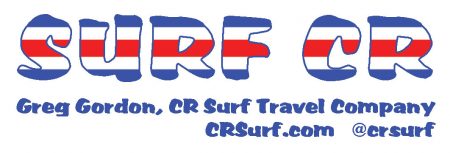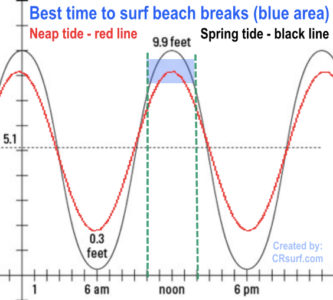My Theory on Waves and the Moon when it Comes to Surfing Beach Breaks
 Many people would think that surfers worship the sun, but in fact it is the moon that makes all the difference in surfing. The phrase “you should have been here an hour ago” is common in surfing because it is the tide that can determine how the swell interacts with the shoreline. If it is too low tide or too high tide then the waves just are not the same.
Many people would think that surfers worship the sun, but in fact it is the moon that makes all the difference in surfing. The phrase “you should have been here an hour ago” is common in surfing because it is the tide that can determine how the swell interacts with the shoreline. If it is too low tide or too high tide then the waves just are not the same.
The moon controls the tides daily, and high tide gets about 50 minutes later each day. In general, beach breaks are better during high tide because the slope of the beach is at a better angle for waves to break evenly. Sometimes though, at dead high tide there is a lull or the ocean is so deep at the takeoff spot that it becomes mushy or just doesn’t break at all. This is why it is important to check the tide charts daily and when planning a trip, try to get high tide in the morning when the chance is better for offshore winds.
 To further expound on the effect of tides on beach breaks, it is also the phases of the moon that make a difference. There is a spring tide when the tide swings are larger (from 0 feet to 10 feet) and a neap tide when the difference in tides is less (from 2 feet to 7 feet). Spring tides take place right after the full or new moon, and here is where the hour you paddle out can make a difference.
To further expound on the effect of tides on beach breaks, it is also the phases of the moon that make a difference. There is a spring tide when the tide swings are larger (from 0 feet to 10 feet) and a neap tide when the difference in tides is less (from 2 feet to 7 feet). Spring tides take place right after the full or new moon, and here is where the hour you paddle out can make a difference.
My theory is that during a spring tide, the window to catch better formed waves is longer—from an hour before high tide to about an hour after. However, there is a longer lull, from 30-40 minutes right at high tide, where it looks less ‘appealing’ (pun intended). An hour after a spring high tide the currents are really sucking out which shortens the ‘wave window’.
During a neap tide the window is shorter because the tide does not come up as far on the part of the beach with a better slope. So the best time to surf during a neap tide is an hour before high tide to an hour after. With a neap tide, the lull is shorter or there may not be one since the depth is just right at high tide. Also the ‘wave window’ extends longer after high tide since the pull of the currents out is not as strong.
This information should help surfers determine the best time to paddle out at Manuel Antonio, Dominical, or Uvita. Don’t forget though that river mouths, reef, and point breaks have different shore depths and therefore generally break better at lower tides. That is another article.
Greg Gordon is the owner of CR Surf Travel Company, helping surfers plan trips to Costa Rica. He has run a weekly surf report since 1998 and has surfed extensively on both the Pacific and Caribbean Coasts. Contact him at [email protected] or on Instagram @crsurf.
